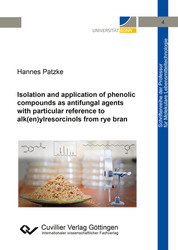| Areas | |
|---|---|
| Serie de libros (96) |
1379
|
| Nachhaltigkeit |
3
|
| Gesundheitswesen |
1
|
| Letra |
2367
|
| Ciencias Naturales |
5407
|
| Matemática | 229 |
| Informática | 319 |
| Física | 980 |
| Química | 1364 |
| Geociencias | 131 |
| Medicina humana | 243 |
| Estomatología | 10 |
| Veterinaria | 108 |
| Farmacia | 147 |
| Biología | 835 |
| Bioquímica, biología molecular, tecnología genética | 121 |
| Biofísica | 25 |
| Nutrición | 45 |
| Agricultura | 1004 |
| Silvicultura | 201 |
| Horticultura | 20 |
| Ecología y conservación de la tierra | 148 |
| Ciencias Ingeniería |
1793
|
| General |
98
|
|
Leitlinien Unfallchirurgie
5. Auflage bestellen |
|
Erweiterte Suche
Isolation and application of phenolic compounds as antifungal agents with particular reference to alk(en)ylresorcinols from rye bran (Volumen 4) (Tienda española)
Hannes Patzke (Autor)Previo
Indice, PDF (65 KB)
Lectura de prueba, PDF (110 KB)
Secondary plant metabolites are part of the plant´s defense system against biotic and abiotic stresses, such as fungal attack. They are often found in large quantities in the outer layers of plant tissues. These metabolites may serve as natural alternatives to synthetic pesticides and may be recovered from by-products of food processing. The work described in this thesis deals with alkylresorcinols from bran, in particular with a novel process for their fractionation based on deep bed filtration at -80 °C and the determination of their antifungal activity against different Fusarium species. In addition, several phenolic compounds were investigated for their efficiency in a fungicide formulation. Ferulic acid proved to be highly efficient against the phytopathogenic fungus Botrytis cinerea. The fungicide formulation depressed spore germination and mycelial growth, inhibited the growth of fungicide-resistant Botrytis cinerea isolates, and effectively reduced the infection of contaminated table grapes.
| ISBN-13 (Impresion) | 9783736998407 |
| ISBN-13 (E-Book) | 9783736988408 |
| Formato | A5 |
| Idioma | Inglés |
| Numero de paginas | 118 |
| Edicion | 1. |
| Serie | Schriftenreihe der Professur für Molekulare Lebensmitteltechnologie |
| Volumen | 4 |
| Lugar de publicacion | Göttingen |
| Lugar de la disertacion | Bonn |
| Fecha de publicacion | 28.08.2018 |
| Clasificacion simple | Tesis doctoral |
| Area |
Química de alimentación
|
| Palabras claves | Alkylresorcine, Ferulasäure, Phenole, natürlicher Pflanzenschutz, Roggenkleie, antifungale Aktivität rye, wheat, Secale cereale, alkylresorcinols, alk(en)ylresorcinols, antifungal activity, phenolic compounds, bran, crystallization, fractionation, isolation, Fusarium spp., natural plant protection, grapes |








